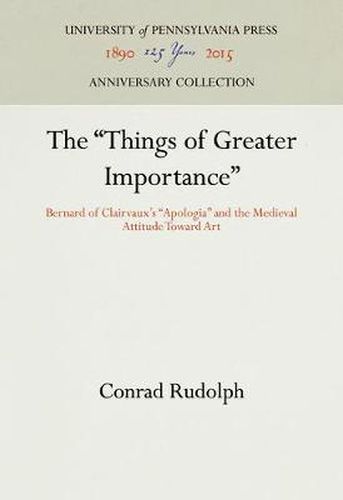Readings Newsletter
Become a Readings Member to make your shopping experience even easier.
Sign in or sign up for free!
You’re not far away from qualifying for FREE standard shipping within Australia
You’ve qualified for FREE standard shipping within Australia
The cart is loading…






This title is printed to order. This book may have been self-published. If so, we cannot guarantee the quality of the content. In the main most books will have gone through the editing process however some may not. We therefore suggest that you be aware of this before ordering this book. If in doubt check either the author or publisher’s details as we are unable to accept any returns unless they are faulty. Please contact us if you have any questions.
The Things of Greater Importance provides a close look into the social and cultural context of medieval art, primarily as expressed in Bernard of Clairvaux’s Apologia, the central document in the greatest artistic controversy to occur in the West prior to the Reformation and the most important source we have for understanding medieval attitudes toward art. Bernard wrote the Apologia during the medieval efflorescence of monumental sculpture and stained glass, of advanced architecture, of pilgrimage art, of high Romanesque, and of the origins of Gothic art.
Rudolph places the Apologia, traditionally seen as a condemnation either of all religious art or of all monastic art, in a broader context, using it to explore the role of art in medieval society. He shows that Bernard was interested in the impact of art on contemporary monasticism in a more complex way than previously believed. The book offers the most thorough study available of the theoretical basis of medieval art as it functioned in society; and its implications for the art of both the Romanesque and Gothic periods, which were spanned by Bernard’s life, are significant.
$9.00 standard shipping within Australia
FREE standard shipping within Australia for orders over $100.00
Express & International shipping calculated at checkout
This title is printed to order. This book may have been self-published. If so, we cannot guarantee the quality of the content. In the main most books will have gone through the editing process however some may not. We therefore suggest that you be aware of this before ordering this book. If in doubt check either the author or publisher’s details as we are unable to accept any returns unless they are faulty. Please contact us if you have any questions.
The Things of Greater Importance provides a close look into the social and cultural context of medieval art, primarily as expressed in Bernard of Clairvaux’s Apologia, the central document in the greatest artistic controversy to occur in the West prior to the Reformation and the most important source we have for understanding medieval attitudes toward art. Bernard wrote the Apologia during the medieval efflorescence of monumental sculpture and stained glass, of advanced architecture, of pilgrimage art, of high Romanesque, and of the origins of Gothic art.
Rudolph places the Apologia, traditionally seen as a condemnation either of all religious art or of all monastic art, in a broader context, using it to explore the role of art in medieval society. He shows that Bernard was interested in the impact of art on contemporary monasticism in a more complex way than previously believed. The book offers the most thorough study available of the theoretical basis of medieval art as it functioned in society; and its implications for the art of both the Romanesque and Gothic periods, which were spanned by Bernard’s life, are significant.